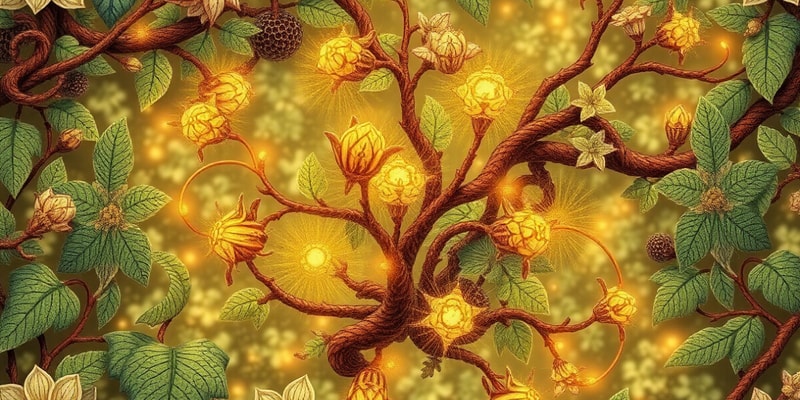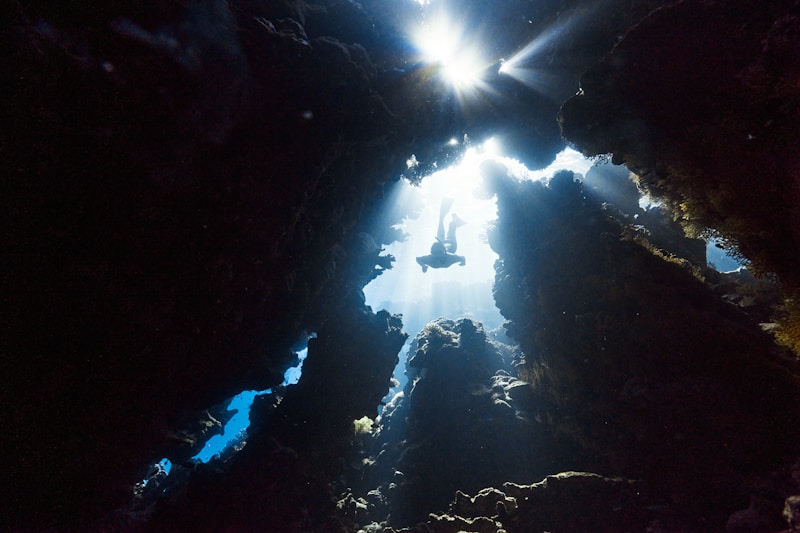Podcast
Questions and Answers
What is the primary role of the waxy cuticle in plants?
What is the primary role of the waxy cuticle in plants?
How do stomata regulate water loss in plants?
How do stomata regulate water loss in plants?
What distinguishes C4 photosynthesis from C3 photosynthesis?
What distinguishes C4 photosynthesis from C3 photosynthesis?
What is the main advantage of Crassulacean Acid Metabolism (CAM)?
What is the main advantage of Crassulacean Acid Metabolism (CAM)?
Signup and view all the answers
How many total photons are required to produce one molecule of O2 through the photosynthetic process?
How many total photons are required to produce one molecule of O2 through the photosynthetic process?
Signup and view all the answers
What is the primary purpose of cyclic electron transport in photosystem I?
What is the primary purpose of cyclic electron transport in photosystem I?
Signup and view all the answers
Which of the following best describes photorespiration?
Which of the following best describes photorespiration?
Signup and view all the answers
Which pigment is primarily involved in capturing light energy in photosystems?
Which pigment is primarily involved in capturing light energy in photosystems?
Signup and view all the answers
What type of process is the Calvin cycle classified as?
What type of process is the Calvin cycle classified as?
Signup and view all the answers
What is the function of the primary electron acceptor in photosystems?
What is the function of the primary electron acceptor in photosystems?
Signup and view all the answers
What additional role does cyclic electron transport serve in photosynthesis?
What additional role does cyclic electron transport serve in photosynthesis?
Signup and view all the answers
What does the P680 molecule in Photosystem II primarily absorb?
What does the P680 molecule in Photosystem II primarily absorb?
Signup and view all the answers
In cyclic electron transport, reduced ferredoxin donates electrons back to which component?
In cyclic electron transport, reduced ferredoxin donates electrons back to which component?
Signup and view all the answers
Which of the following best describes the role of NADPH in the Calvin cycle?
Which of the following best describes the role of NADPH in the Calvin cycle?
Signup and view all the answers
What happens to protons during cyclic electron transport?
What happens to protons during cyclic electron transport?
Signup and view all the answers
What is the primary product of the light reactions of photosynthesis?
What is the primary product of the light reactions of photosynthesis?
Signup and view all the answers
What primary function does the waxy cuticle serve in terrestrial plants?
What primary function does the waxy cuticle serve in terrestrial plants?
Signup and view all the answers
How do stomata contribute to a plant's survival in hot, dry climates?
How do stomata contribute to a plant's survival in hot, dry climates?
Signup and view all the answers
Which advantage does C4 photosynthesis provide to certain plants?
Which advantage does C4 photosynthesis provide to certain plants?
Signup and view all the answers
What is the role of PEP carboxylase in C4 photosynthesis?
What is the role of PEP carboxylase in C4 photosynthesis?
Signup and view all the answers
In which environment are algae particularly challenged to achieve optimal CO2 concentrations for photosynthesis?
In which environment are algae particularly challenged to achieve optimal CO2 concentrations for photosynthesis?
Signup and view all the answers
What mechanism do CAM plants use to minimize photorespiration?
What mechanism do CAM plants use to minimize photorespiration?
Signup and view all the answers
What is the primary outcome of increased photorespiration in plants?
What is the primary outcome of increased photorespiration in plants?
Signup and view all the answers
What describes the relationship between the C4 pathway and the Calvin cycle in plants that utilize C4 photosynthesis?
What describes the relationship between the C4 pathway and the Calvin cycle in plants that utilize C4 photosynthesis?
Signup and view all the answers
What is the main reason that certain algae pump bicarbonate ions into their cells?
What is the main reason that certain algae pump bicarbonate ions into their cells?
Signup and view all the answers
How does high temperature affect photorespiration?
How does high temperature affect photorespiration?
Signup and view all the answers
Which adaptation is seen in plants in response to the dilemma of maintaining CO2 uptake while conserving water?
Which adaptation is seen in plants in response to the dilemma of maintaining CO2 uptake while conserving water?
Signup and view all the answers
What advantage does the accumulation of malate during the nighttime provide to CAM plants?
What advantage does the accumulation of malate during the nighttime provide to CAM plants?
Signup and view all the answers
What distinguishes the C4 pathway from the Calvin cycle?
What distinguishes the C4 pathway from the Calvin cycle?
Signup and view all the answers
Study Notes
Photosynthesis Overview
- Photosynthesis uses light energy to convert carbon dioxide (CO2) into organic compounds.
- Oxygen (O2) is released as a byproduct.
- This process provides the food source for all living organisms, directly or indirectly.
Metabolic Classification of Organisms
- Organisms are classified based on their energy and carbon source.
- Phototrophs obtain energy from light.
- Chemotrophs obtain energy from chemical compounds.
- Autotrophs acquire carbon from inorganic sources like CO2.
- Heterotrophs acquire carbon from organic sources like sugars.
- Examples of each type are provided:
- Photoautotrophs: vascular plants, cyanobacteria
- Photoheterotrophs: most green non-sulfur bacteria, heliobacteria
- Chemoautotrophs: sulfur-oxidizing bacteria, hydrogen bacteria
- Chemoheterotrophs: most bacteria, animals
Autotrophs and Heterotrophs
- Autotrophs produce their own organic molecules from inorganic materials.
- Heterotrophs must consume organic molecules for energy and building blocks.
Photoautotrophs
- Organisms that convert light into usable chemical energy via photosynthesis.
- The chemical energy produced sustains all life on Earth.
Photosynthetic Organisms
- Convert light into chemical energy
- Use chemical energy to make complex organic molecules from inorganic (non-living) raw materials.
- The organic molecules are used as energy sources for other organisms.
Two Stages of Photosynthesis
- Light reactions:
- Pigment molecules absorb light energy, converting it into chemical energy in ATP and NADPH.
- Water is oxidized, releasing oxygen as a byproduct.
- Calvin cycle:
- ATP and NADPH provide energy and reducing power for the Calvin cycle.
- Carbon dioxide (CO2) is fixed into organic compounds (carbohydrates).
Photosynthesis is a Redox Reaction
- Light energy fuels the conversion of CO2 and water into glucose, with oxygen released.
- Oxidation: loss of electrons, releases energy.
- Reduction: gain of electrons, requires energy.
- This process involves a series of oxidation-reduction reactions.
Chloroplasts
- Photosynthesis takes place in chloroplasts, organelles found in eukaryotic organisms (plants and algae).
- Chloroplasts have an outer and inner membrane, stroma, and thylakoids.
- The stroma is the fluid-filled space surrounding the thylakoids where the Calvin cycle occurs.
- Thylakoids are membrane-bound structures containing chlorophyll, the pigment that captures light energy.
Chloroplast Structure
- Chloroplasts are surrounded by a double membrane.
- Inside the chloroplast, there's a fluid-filled space called the stroma, where carbohydrate synthesis (Calvin cycle) happens.
- Within the membrane are interconnected thylakoid membranes where light-dependent reactions take place.
- Stacks of thylakoids are called grana, connected by tubules.
Photosynthesis Impacts Global CO2 Levels
- Chlorophyll/chloroplasts can be observed from space, highlighting the impact of photosynthesis on global CO2 levels.
- CO2 levels vary over the year, increasing through the winter due to limited photosynthesis in the Northern Hemisphere and decreasing in the spring and summer as photosynthesis resumes.
- NASA provides relevant data on CO2 levels.
Light and Electromagnetic Spectrum
- Light is the ultimate energy source for most organisms.
- The sun converts matter into electromagnetic radiation.
- The electromagnetic spectrum encompasses various forms of radiation that differ in wavelengths.
- Visible light is a portion of the spectrum detectable by the human eye.
Visible Light and Photons
- Visible light spans from red (700 nm) to blue (400 nm).
- White light is the combination of all visible wavelengths.
- Photon energy and wavelength are inversely proportional.
- Shorter wavelengths equate to higher energy photons.
Light Interacts With Matter
- Photons interacting with an object can be reflected, transmitted, or absorbed.
- Absorption is necessary for using light's energy by transferring the energy to an electron within a molecule, exciting it from a grounded to an excited state.
Pigments Absorb Photons
- Pigments are molecules that absorb specific wavelengths of light.
- The structures of pigments result in many excitable electrons that capture light energy.
- Structure of pigments is critical for light absorption, including conjugated systems.
- A pigment's color is defined by the wavelengths it does not absorb.
Pigments
- Pigments are molecules efficient at absorbing visible light.
- They have specific structures allowing for the absorption of a diverse range of light wavelengths.
- An example is chlorophyll, a key photosynthetic pigment.
Fates of an Excited-State Electron
- An excited electron returns to its ground state, releasing energy as heat or light.
- Energy transfer via inductive resonance excites neighboring pigment molecules.
- Excited electron can be transferred to a nearby electron-accepting molecule in photoreduction. There are three fates for an excited electron Photosynthesis can be examined at an individual electron level
Chlorophyll and Carotenoids
- Chlorophyll is the main photosynthetic pigment in plants, algae, and cyanobacteria.
- Chlorophyll a is critical for light absorption.
- Chlorophyll b and carotenoids are accessory pigments.
- They transfer absorbed energy to chlorophyll a.
Chlorophyll and Carotenoids, continued
- Light energy absorbed by carotenoids and chlorophylls drives photosynthesis.
- Absorption spectrum details the absorbance of different wavelengths of light, which are important to capture light energy.
- Action spectrum measures the effectiveness of different light wavelengths in driving the process of photosynthesis.
Engelmann's Experiment
- In 1883, Engelmann investigated the impact of different light wavelengths on photosynthesis using bacteria.
- He observed that oxygen production was greatest in blue and red light.
- The experiment yielded an action spectrum for photosynthesis for specific wavelengths.
Two Stages of Photosynthesis (recap)
- Light reactions capture light energy and convert it into chemical energy in ATP and NADPH.
- Calvin cycle utilizes ATP and NADPH to convert CO2 into organic molecules.
Major Components of a Photosystem
- Antenna complex absorbs light energy and transfers it to the reaction center.
- Reaction center contains chlorophyll a molecules, where light energy is converted to chemical energy.
- Primary electron acceptor captures excited electrons.
- Energy transfer within Photosystems is via inductive resonance.
Photosystems I and II
- Photosystems consist of pigment and protein complexes.
- Photosystem II (PSII) oxidizes water, producing oxygen (O2).
- Photosystem I (PSI) reduces NADP+ to NADPH.
Two Photosystems (recap)
- Photosystems I and II are connected by an electron transport chain.
- These systems facilitate electron flow from water to NADP+.
Photosystem II
- P680, a chlorophyll a molecule, absorbs light energy.
- P680* gets oxidized to P680+ by a primary electron acceptor (Pheophytin).
- Shuttles electrons to the cytochrome complex and ultimately to Photosystem I.
Photosynthetic Electron Transport and ATP Synthesis
- Electrons from PSII are transferred along an electron transport chain.
- Energy released is used to generate ATP and NADPH.
- A proton gradient across the thylakoid membrane drives ATP production via chemiosmosis.
Linear Electron Transport 1, 2, 3, 4, 5
- Light absorption by Photosystem II (PSII) excites electrons, initiating electron flow. These processes are essential for generating NADPH and ATP needed for the Calvin Cycle in photosynthesis
Chemiosmotic Synthesis of ATP
- A proton gradient is established across the thylakoid membrane from PSII, and related processes.
- ATP synthase uses this gradient to generate ATP in the stroma.
Energy Levels in Thylakoid Membrane
- Light energy absorption by PSI excites P700, initiating electron flow. Light energy is directly converted to useful chemical energy Light energy is converted to chemical energy (ATP and NADPH) driving power for the next stage of photosynthesis - Calvin Cycle.
Stoichiometry of Photosynthesis
- Determine how many photons are required to produce 1 molecule of oxygen.
- 8 photons are needed for the oxidation of 2 water molecules and generation of one molecule of O2
Cyclic Electron Transport
- Electron flow from PSI to ferredoxin can be diverted back to the plastoquinone pool.
- ATP production is augmented without producing NADPH
- Additional ATP is needed if not utilizing NADPH to maximize productivity
Calvin Cycle Summary
- CO2 fixation captures CO2, ultimately converting it into sugars.
- Provides critical organic carbon compounds
- The Calvin cycle is an anabolic, endergonic process, needing inputs of ATP and NADPH.
Rubisco
- Rubisco is the key enzyme for carbon fixation in the Calvin Cycle.
- Rubisco is the most abundant protein on Earth
- 100 billion tons of CO2 are converted into carbohydrates each year
Rubisco Oxygenase Activity
O2 inhibits Rubisco, leading to photorespiration.
- At higher temperatures, O2 outcompetes CO2, causing carbon loss.
- Different plants have evolved strategies to minimize photorespiration.
Carbon-Concentrating Mechanisms in Algae
- CO2 concentration in aquatic environments is often lower than needed for optimal photosynthesis, requiring specialized mechanisms.
- Some algae actively pump CO2 into their cells to increase its concentration near the photosynthetic machinery.
Dilemma of Plants in Hot Dry Climates
- Plants balance the need to absorb CO2 with water conservation in hot, dry climates.
- Stomata open to let in CO2 but need to be regulated carefully to prevent excessive water loss.
- This leads to tradeoffs in productivity.
Photorespiration and Temperature
- Temperature affects CO2 and O2 solubility, which can affect the rate of photorespiration.
- Higher temperatures increase photorespiration, as O2 competes more efficiently with CO2 for Rubisco.
C4 Photosynthesis
- Some plants evolved a C4 pathway to minimize photorespiration.
- Involves combining CO2 with a 3-carbon molecule (PEP) to form a 4-carbon compound.
- The 4-carbon molecule is then transported to bundle-sheath cells, where CO2 is released for the Calvin cycle.
C4 and CAM Pathways
- Different C4 plants utilize spatial or temporal separation of the C4 and Calvin cycles, respectively.
- CAM pathways store CO2 at night and use it during the day.
Studying That Suits You
Use AI to generate personalized quizzes and flashcards to suit your learning preferences.
Related Documents
Description
Explore the fascinating processes behind photosynthesis and the metabolic classification of organisms. This quiz covers how organisms obtain energy and carbon, detailing the distinctions between autotrophs and heterotrophs. Test your understanding of these vital biological concepts.




